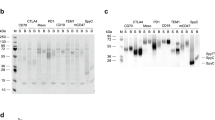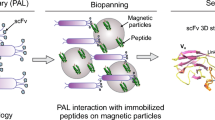Summary
The detailed specificity of monoclonal antibody M1, which has been reported to bind in a calcium-dependent manner to the ‘FLAG’ sequence DYKDDDDK-NH2, was examined using soluble hexa- and decapeptide positional scanning synthetic combinatorial libraries (PS-SCLs) made up of 52×106 and 4×1012 different sequences, respectively. To study the influence of calcium on the specificity of this antigen-antibody interaction, each PS-SCL was screened in the presence and absence of calcium using a competitive ELISA. Overall, peptide mixtures had greater inhibitory activity against mAb M1 binding to FLAG in the absence of calcium. A total of 16 individual hexapeptides were identified, all of which contained the motif -DYK_K_-, and were recognized by mAb M1 in the absence of calcium with 50-to 100-fold higher affinity than the FLAG octapeptide (IC50=273 nM). On average, the same set of peptides bound 10-fold less effectively in the presence of calcium. Upon screening the decapeptide PS-SCL in the absence of calcium, lysine was also more active in the fifth position than the original aspartic acid. Based on the screening results, 24 individual decapeptides were prepared and were found to have activities 10- to 100-fold higher than the FLAG octapeptide in the absence of calcium. The specificity of lysine at the fifth position in the antigen-antibody interaction was further examined by synthesizing and assaying substitution analogs at this position for the octapeptide and hexapeptide forms of the FLAG sequence, as well as for two hexapeptides identified from the PS-SCL. Truncation analog analysis was also carried out on the FLAG octapeptide to determine optimal antigen length for antibody binding. Overall, lysine at the fifth position could be substituted with ornithine with no significant loss in activity, and peptide length was not a critical factor for antibody binding in the absence of calcium. Also, the octapeptide having lysine at the fifth position in place of the aspartic acid had the same activity in the presence or absence of calcium. This study demonstrates the ease and effectiveness of PS-SCLs over individual peptide analogs for the examination of the degree of cross-reactivity for a given monoclonal antibody as well as for the identification of novel, high-affinity peptides.
Similar content being viewed by others
References
Pinilla, C., Appel, J., Blondelle, S.E., Dooley, C.T., Dörner, B., Eichler, J., Ostresh, J.M. and Houghten, R.A.,A review of the utility of peptide combinatorial libraries, Biopolymers (Peptide Science), 37 (1995) 221–240.
Pinilla, C., Appel, J.R., Blanc, P. and Houghten, R.A.,Rapid identification of high affinity peptide ligands using positional scanning synthetic peptide combinatorial libraries, Biotechniques, 13 (1992) 901–905.
Houghten, R.A., Pinilla, C., Blondelle, S.E., Appel, J.R., Dooley, C.T. and Cuervo, J.H.,Generation and use of synthetic peptide combinatorial libraries for basic research and drug discovery, Nature, 354 (1991) 84–86.
Hopp, T.P., Prickelt, K.S., Price, V.L., Libby, R.T., March, C.J., Cerretti, D.P., Urdal, D.L. and Conlon, P.A.,Short polypeptide marker sequence useful for recombinant protein identification and purification, Biotechnology, 6 (1988) 1204–1210.
Prickett, K.S., Amberg, D.C. and Hopp, T.P.,A calcium-dependent antibody for the identification and purification of recombinant proteins, Biotechniques, 7 (1989) 580–589.
Knappik, A. and Plückthun, A.,An improved affinity tag on the FLAG peptide for the detection and purification of recombinant antibody fragments, Biotechniques, 17 (1994) 754–761.
Miceli, R.M., DeGraaf, M.E. and Fischer, H.D.,Two-stage selection of sequences from a random phage display library delineates both core residues and permitted structural range within an epitope, J. Immunol. Melhods, 167 (1994) 279–287.
Schmidt, T.G.M. and Skerra, A.,The random peptide library-assisted engineering of a C-terminal affinity peptide, useful for the detection and purification of a functional Ig Fv fragment, Protein Eng., 6 (1993) 109–122.
Hai, T. and Chen, B.P.C.,Expression vectors for affinity purification and radiolabeling of proteins using Escherichia coli as host, Gene, 139 (1994) 73–75.
Ostresh, J.M., Winkle, J.H., Hamashin, V.T. and Houghten, R.A.,Peptide libraries: Determination of relative reaction rates of protected amino acids in competitive couplings, Biopolymers, 34 (1994) 1681–1689.
Tam, J.P., Heath, W.F. and Merrifield, R.B., SN2deprotection of synthetic peptides with a low concentration of HF in dimethyl sulfide: Evidence and application in peptide synthesis, J. Am. Chem. Soc., 105 (1983) 6442–6455.
Houghten, R.A., Bray, M.K., De Graw, S.T. and Kirby, C.J.,Simplified procedure for carrying out simultaneous multiple hydrogen fluoride cleavages of protected peptide resins, Int. J. Pept. Protein Res., 27 (1986) 673–678.
Pinilla, C., Appel, J.R. and Houghlen, R.A.,Investigation of antigen-antibody interactions using a soluble nonsupport-boundsynthetic decapeptide library composed of four trillion sequences, Biochem. J., 301 (1994) 847–853.
Houghten, R.A.,General method for the rapid solid-phase synthesis of large numbers of peptides: Specificity of antigen-antibody interaction at the level of individual amino acids, Proc. Natl. Acad. Sci. USA, 82 (1985) 5131–5135.
Hopp, T.P.,Immunogenicity of a synthetic HBsAg peptide: Enhancement by conjugation to a fatty acid carrier, Mol. Immunol., 21 (1984) 13–16.
Appel, J.R., Pinilla, C., Niman, H. and Houghten, R.A.,Elucidation of discontinuous linear determinants in peptides, J. Immunol., 144 (1990) 976–983.
Appel, J.R., Buencamino, J., Houghlen, R.A. and Pinilla, C.,Study of peptide-antibody interactions using a decapeptide positional scanning library, In Maia, H.L.S. (Ed.) Peptides 1994 (Proceedings of the 23rd European Peptide Symposium), ESCOM, Leiden, 1995, pp. 815–816.
Walerson, D.M., Sharief, F. and Vanaman, T.C.,The complete amino acid sequence of the Ca 2+-dependent modulator protein (calmodulin) of bovine brain, J. Biol. Chem., 255 (1980) 962–975.
Gulino, D., Boudignon, C., Zhang, L., Concord, E., Rabiel, M. and Marguerie, G.,Ca 2+-binding properties of the platelet glycoprotein IIb ligand-interacting domain, J. Biol. Chem., 267 (1992) 1001–1007.
Pinilla, C., Appel, J.R. and Houghlen, R.A.,Functional importance of amino acid residues making up peptide antigenic determinants, Mol. Immunol., 30 (1993) 577–585.
Author information
Authors and Affiliations
Rights and permissions
About this article
Cite this article
Pinilla, C., Buencamino, J., Appel, J.R. et al. Mapping the detailed specificity of a calcium-dependent monoclonal antibody through the use of soluble positional scanning combinatorial libraries: Identification of potent calcium-independent antigens. Mol Divers 1, 21–28 (1995). https://doi.org/10.1007/BF01715806
Received:
Accepted:
Issue Date:
DOI: https://doi.org/10.1007/BF01715806




